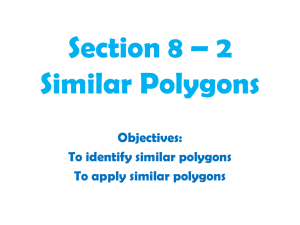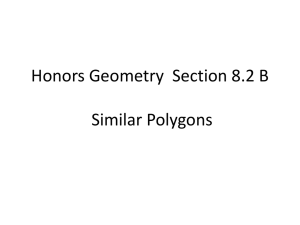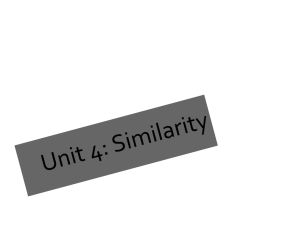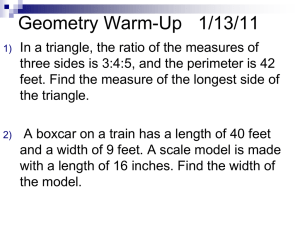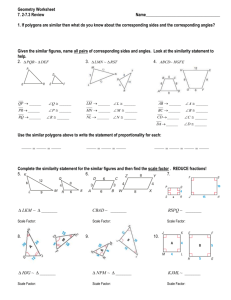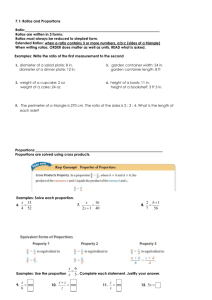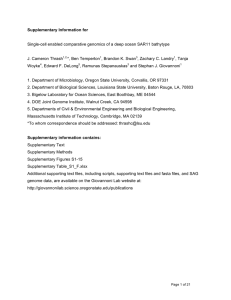SS9.3 Post Teacher aug12
advertisement
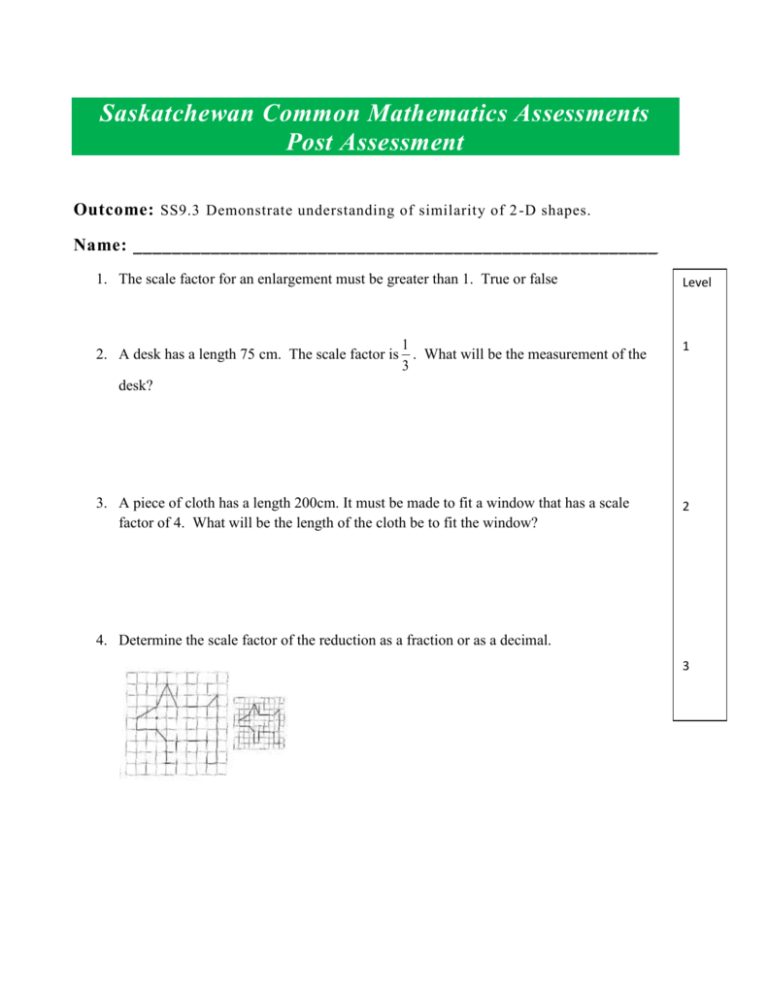
Saskatchewan Common Mathematics Assessments Post Assessment Outcome: SS9.3 Demonstrate understanding of similarity of 2 -D shapes. Name: ______________________________________________________ 1. The scale factor for an enlargement must be greater than 1. True or false Level 1 2. A desk has a length 75 cm. The scale factor is . What will be the measurement of the 3 desk? 1 3. A piece of cloth has a length 200cm. It must be made to fit a window that has a scale factor of 4. What will be the length of the cloth be to fit the window? 2 4. Determine the scale factor of the reduction as a fraction or as a decimal. 3 5. These two pentagons are similar. Determine the value of x. 6. Determine the length of HG. 7. Determine the length of RS in these similar triangles. 8. Find two polygon pairs of corresponding lengths that are proportional. Identify the scale factor for the reduction. Level 4 9. Copy the diagram on 1cm grid paper. Draw a reduction of the diagram with a scale factor of 3 . 4 Teacher Section Teacher Notes: Students will require a calculator and 1cm grid paper. Question Indicator Level Answer Key: Answer 1 SS9.3 j 1 True 2 SS9.3 f 2 25cm 3 SS9.3 f 2 800cm 4 SS9.3 c, k 3 1 or 0.5 2 5 SS9.3 l 3 X = 8cm 6 SS9.3 l 3 DG GF DH HE 4 HG 17.5 4 7 4 4 HG 17.5 4 4 7 4 HG 17.5 4 7 4 HG 10 4 HG 4 10 4 HG 6 The length of HG is 6 units. 7 SS9.3 l 3 117.6m 8 SS9.3 c, k 4 9 SS9.3 e, i 4 Polygons PR; Scale factor 0f 1 2 Outcome: SS9.3 Demonstrate understanding of similarity of 2-D shapes. up to Level 1 Description of Levels: (based on Marzano, 2007) There is a partial understanding of some of the simpler details and processes. Prior knowledge is understood. Terminology: two dimensional, Indicators and Learning Targets for each Level: Studentfriendly descriptions of learning targets. Skills: calculating ratio up to Level 2 up to Level 3 No major errors or omissions regarding the simpler details or processes, but major errors or omissions regarding the complex processes may be present. No major errors or omissions regarding any of the information and/or processes that were explicitly taught. This is the target level for proficiency. (a) Observe and describe 2-D shapes, relevant to self, family, or community, that are similar. (b) Explain the difference between similarity and congruence of polygons. (d) Explain how ratios and proportionality are related to similarity of polygons. (g) Identify and describe situations relevant to self, family, or community that involve scale diagrams and explain the meaning of the scale factor involved. (h) Explain how scale diagrams are related to similarity, ratios, and proportionality. (j) Explain how to determine the scale factor for a given 2-D shape and an enlargement or reduction of the shape. (a)I can observe and describe 2-D shapes, relevant to self, family, or community, that are similar. (b)I can explain the difference between similar and equality of polygons. (d)I can explain how ratios and proportion are related to similarity of polygons. (g)I can identify and describe situations relevant to self, family, or community that involve scale diagrams and explain the meaning of the scale factor involved. (h)I can explain how scale diagrams are related to similarity, ratios, and proportionality. (j)I can explain how to determine the scale factor for a given 2-D shape and an enlargement or reduction of the shape. (c) Verify whether or not two polygons are similar. (e) Draw a polygon similar to a given polygon and explain the strategies used. (f) Solve situational questions involving the similarity of polygons. (i) Draw a diagram to scale that represents an enlargement or reduction of a given 2-D shape and explain the strategies used. (k) Verify whether or not a given diagram is a scale diagram of a 2-D shape and, if it is, identify the scale factor for the diagram. (l) Solve situational questions involving scale diagrams and scale factors. (c)I can prove whether or not two polygons are similar. (e)I can draw a polygon similar to a given polygon and explain the strategies used. (f)I can solve situational questions involving the similarity of polygons. (i)I can draw a diagram to scale that represents an enlargement or reduction of a given 2-D shape and explain the strategies used. (k)I can confirm whether or not a given diagram is a scale diagram of a 2-D shape and, if it is, identify the scale factor for the diagram. (l)I can solve situational questions involving scale diagrams and scale factors. up to Level 4 In addition to level 3 performance, indepth inferences and applications go beyond what was explicitly taught. Problem combining surface area and similar 3D objects
